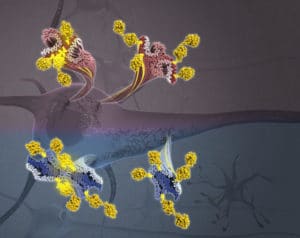Kryo-Elektronenmikroskopie liefert Einblicke in die Rolle von Tau bei neurodegenerativen Erkrankungen

Neue AFTD-finanzierte Forschung published February 6 in the scientific journal Zelle provides new and important insights into tau protein accumulation and its connections to a range of neurodegenerative diseases, including FTD.
While abnormal accumulation of tau in the brain is understood to be a hallmark of about 50% of all cases of FTD, as well as Alzheimer’s disease and other brain disorders, scientists have yet to understand exactly how the protein converts from its normal, functional form into a misfolded, harmful one.
Das neue Studie – led by Anthony Fitzpatrick, PhD, of Columbia University’s Mortimer B. Zuckerman Mind Brain Behavior Institute – has provided new insights into the protein’s structure that could advance the fight against FTD and other forms of dementia and neurodegenerative disease.

Tau filaments decorated with ubiquitin chains (yellow) from corticobasal degeneration (blue/navy) and Alzheimer’s disease (red/purple) emanating from a neuron (Credit: Veronica Falconieri Hays and Anthony Fitzpatrick/Columbia University’s Zuckerman Institute)
Fitzpatrick, along with additional researchers at Columbia University as well as the Mayo Clinic in Florida and the Emory University School of Medicine in Atlanta, used the cutting-edge technology known as cryo-electron microscopy, or Cryo-EM, to visualize tau filaments in unprecedented detail. The investigators paired cryo-EM with a second technique, mass spectrometry, to obtain additional information about the chemical make-up of molecules on the surface of tau. Their work revealed important features of tau in brains affected by Alzheimer’s disease and corticobasal degeneration (an FTD subtype). This could help researchers to identify biomarkers to detect such diseases before symptoms arise – a crucial step toward developing treatments to prevent disease onset before the brain is physically damaged — or develop drugs that target disease-related changes in tau structure and behavior.
Dr. Fitzpatrick plans to continue to expand his work to other tauopathies – neurodegenerative disorders characterized by the deposition of abnormal tau.
“Our findings will inspire new approaches for developing diagnostic tools and designing drugs,” Dr. Fitzpatrick said in a Pressemitteilung. “Neurodegenerative diseases are among the most complex and distressing class of illnesses, but through our work and that of our colleagues and collaborators, we are building a roadmap toward successful diagnostics and therapeutics.”
This innovative research was funded in part by an AFTD research award, provided through our FTD Biomarkers Initiative to Dr. Fitzpatrick. (Study co-corresponding author Dr. Leonard Petrucelli of Mayo Clinic Jacksonville is also an FTD Biomarkers Initiative award recipient.) The FTD-Biomarker-Initiative is a major AFTD funding opportunity that supports innovative science to spur the discovery and development of FTD biomarkers.
Pictured above, Anthony Fitzpatrick at the cryo-EM microscope (John Abbott for Columbia University’s Zuckerman Institute)
Nach Kategorie
Unsere Newsletter
Bleib informiert
Melden Sie sich jetzt an und bleiben Sie mit unserem Newsletter, Veranstaltungsbenachrichtigungen und mehr auf dem Laufenden …
